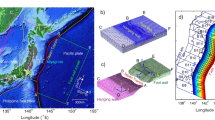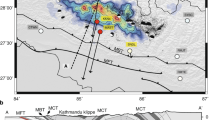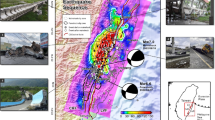Abstract
Southwestern Japan lies at the boundary between the subducting Philippine Sea plate and the overriding Eurasian plate. A magnitude 8 megathrust earthquake ruptured the Tonankai and Nankai segments in 1944 and 1946, respectively, but the neighbouring Tokai segment of the plate boundary remained locked1. A large megathrust earthquake in the Tokai region has therefore been expected. In 2009, a magnitude 6.4 earthquake took place in Suruga Bay, within the Philippine Sea subducting plate, close to the Tokai segment. Here, we use a fault-slip model to examine the impact of the stress changes2 caused by the Suruga Bay event on the Tokai segment. We show that the occurrence rate of plate-boundary seismicity increased following the earthquake. Most of the presumed strongly locked patches of the Tokai segment are located within areas of increased stress. Rupturing of a locked patch—following a threshold level of seismic stress—could trigger the rupture of the entire Tokai segment, leading to a megathrust earthquake.
This is a preview of subscription content, access via your institution
Access options
Subscribe to this journal
Receive 12 print issues and online access
$259.00 per year
only $21.58 per issue
Buy this article
- Purchase on Springer Link
- Instant access to full article PDF
Prices may be subject to local taxes which are calculated during checkout




Similar content being viewed by others
References
Ando, M. Source mechanisms and tectonic significance of historic earthquakes along the Nankai trough, Japan. Tectonophysics 27, 119–140 (1975).
Stein, R. S. The role of stress transfer in earthquake occurrence. Nature 402, 605–609 (1999).
Lay, T., Astiz, L., Kanamori, H. & Christensen, D. H. Temporal variation of large intraplate earthquakes in coupled subduction zones. Phys. Earth Planet. Inter. 54, 258–312 (1989).
Waldhauser, F. & Ellsworth, W. L. A double-difference earthquake location algorithm: Method and application to the Northern Hayward fault, California. Bull. Seismol. Soc. Am. 90, 1353–1368 (2000).
Okada, Y. et al. Recent progress of seismic observation networks in Japan—Hi-net, F-net, K-NET and KiK-net. Earth Planet. Space 56, xv–xxviii (2004).
Hartzell, S. H. & Heaton, T. H. Inversion of strong ground motion and teleseismic waveform data for the fault rupture history of the 1979 Imperial Valley, California, earthquake. Bull. Seismol. Soc. Am. 73, 1553–1583 (1983).
Robinson, D. P., Henry, C., Das, S. & Woodhouse, J. H. Simultaneous rupture along two conjugate planes of the Wharton Basin earthquake. Science 292, 1145–1148 (2001).
Central Disaster Prevention Council of Japan. Special committee report of the Tokai earthquake (in Japanese). 17pp.; available at http://www.bousai.go.jp/jishin/chubou/20011218/siryou2-2.pdf.
Matsumura, S. Focal zone of a future Tokai earthquake inferred from the seismicity pattern around the plate interface. Tectonophysics 273, 271–291 (1997).
Matsumura, S., Satomura, M. & Uchiumi, S. Presumption of asperities for the anticipated Tokai earthquake (seismic activity change and crustal deformation in the Tokai region: Part 5) [in Japanese with English abstract]. Zisin 60, 267–277 (2008).
Ozawa, S. et al. Detection and monitoring of ongoing aseismic slip in the Tokai region, central Japan. Science 298, 1009–1012 (2002).
Parsons, T., Ji, C. & Kirby, E. Stress changes from the 2008 Wenchuan earthquake and increased hazard in the Sichuan basin. Nature 454, 509–510 (2008).
Toda, S., Stein, R. S., Reasenberg, P. A., Dieterich, J. H. & Yoshida, A. Stress transferred by the 1995 Mw=6.9 Kobe, Japan, shock: Effect on aftershocks and future earthquake probabilities. J. Geophys. Res. 103, 24543–24565 (1998).
Ohta, Y., Kimata, F. & Sagiya, T. Reexamination of the interplate coupling in the Tokai region, central Japan, based on the GPS data in 1997–2002. Geophys. Res. Lett. 31, L24604 (2004).
Dieterich, J. A constitutive law for rate of earthquake production and its application to earthquake clustering. J. Geophys. Res. 99, 2601–2618 (1994).
King, G. C. P., Stein, R. S. & Lin, J. Static stress changes and the triggering of earthquakes. Bull. Seismol. Soc. Am. 84, 935–953 (1994).
Stein, R. S., Barka, A. A. & Dieterich, J. H. Progressive failure on the North Anatolian fault since 1939 by earthquake stress triggering. Geophys. J. Int. 128, 594–604 (1997).
Toda, S. & Stein, R. S. Toggling of seismicity by the 1997 Kagoshima earthquake couplet: A demonstration of time-dependent stress transfer. J. Geophys. Res. 108, 2567 (2003).
Ukawa, M., Ishida, M., Matsumura, S. & Kasahara, K. Hypocenter determination method of the Kanto–Tokai observational network for microearthquakes [in Japanese with English abstract]. Rep. Natl. Res. Cent. Disaster Prev. 53, 1–88 (1984).
Bouchon, M. A simple method to calculate Green’s functions for elastic layered media. Bull. Seismol. Soc. Am. 71, 959–971 (1981).
Kennett, B. L. N. & Kerry, N. J. Seismic waves in a stratified half space. Geophys. J. R. Astron. Soc. 57, 557–583 (1979).
Toda, S., Stein, R. S., Richards-Dinger, K. & Bozkurt, S. B. Forecasting the evolution of seismicity in southern California: Animations built on earthquake stress transfer. J. Geophys. Res. 110, B05S16 (2005).
Hainzl, S. et al. Aftershock modeling based on uncertain stress calculations. J. Geophys. Res. 114, B05309 (2009).
Utsu, T. A statistical study on the occurrence of aftershocks. Geophysics 30, 521–605 (1961).
Ogata, Y. Estimation of the parameters in the modified Omori formula for aftershock frequencies by the maximum likelihood procedure. J. Phys. Earth 31, 115–124 (1983).
Acknowledgements
We thank Y. Okada, S. Hainzl, S. Matsumura, H. Hirose, Y. Ben-Zion, M. Imoto, S. Noguchi, Z. Peng and T. Miyoshi for discussions and reviews of the manuscript. M. Matsubara provided information on the focal mechanism of the triggered seismicity. The suggestions of T. Tada were helpful to improve the clarity and conciseness of the text.
Author information
Authors and Affiliations
Contributions
S.A. and B.E. conceived the analysis and wrote the paper. S.A., B.E., W.S. and Y.A. carried out the analysis. All the authors contributed to the observations.
Corresponding authors
Ethics declarations
Competing interests
The authors declare no competing financial interests.
Supplementary information
Supplementary Information
Supplementary Information (PDF 1576 kb)
Supplementary Movie
Supplementary Information (MOV 2480 kb)
Rights and permissions
About this article
Cite this article
Aoi, S., Enescu, B., Suzuki, W. et al. Stress transfer in the Tokai subduction zone from the 2009 Suruga Bay earthquake in Japan. Nature Geosci 3, 496–500 (2010). https://doi.org/10.1038/ngeo885
Received:
Accepted:
Published:
Issue Date:
DOI: https://doi.org/10.1038/ngeo885
This article is cited by
-
MOWLAS: NIED observation network for earthquake, tsunami and volcano
Earth, Planets and Space (2020)
-
Source fault model of the 2018 Mw 5.6 northern Osaka earthquake, Japan, inferred from the aftershock sequence
Earth, Planets and Space (2019)
-
A b map implying the first eastern rupture of the Nankai Trough earthquakes
Nature Communications (2018)
-
Examination of the largest-possible tsunamis (Level 2) generated along the Nankai and Suruga troughs during the past 4000 years based on studies of tsunami deposits from the 2011 Tohoku-oki tsunami
Progress in Earth and Planetary Science (2016)
-
A new landslide-induced tsunami simulation model and its application to the 1792 Unzen-Mayuyama landslide-and-tsunami disaster
Landslides (2016)



